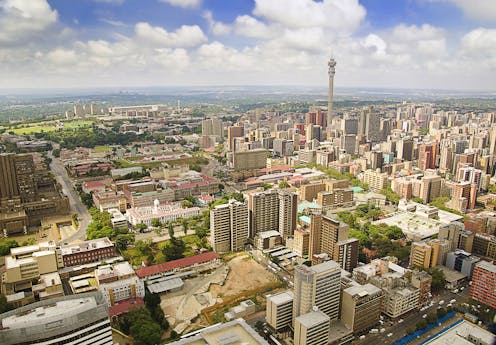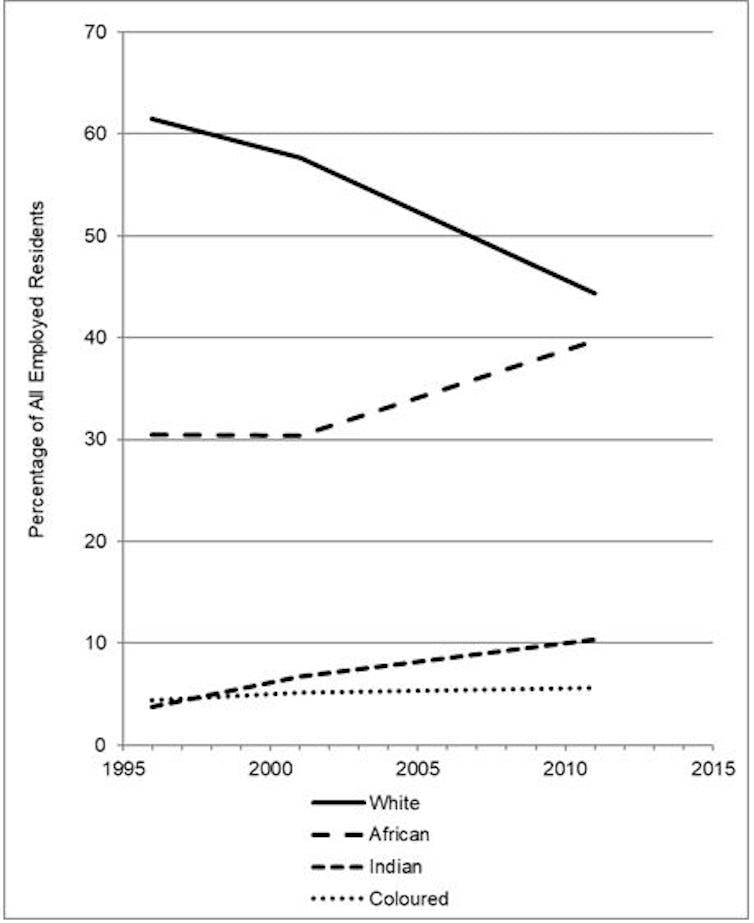
Scholars disagree about whether the formerly whites-only neighbourhoods of Johannesburg, South Africa’s largest and most economically important city, have become substantially desegregated since the end of apartheid in 1994. Some argue that racial residential segregation has declined only slightly, while others argue that it is substantial.
My recent research shows that the extent of racial desegregation is much more substantial than is commonly accepted. This research is based on population census data for the years 1996, 2001 and 2011 and is a result of my long-term scholarly interest in the changing nature and extent of racial inequality in Johannesburg.
The extent of racial residential desegregation of the formerly whites-only neighbourhoods of Johannesburg would indicate the progress that democratic South Africa has made towards achieving a racially equal society. The other main indicators are changes in earnings inequality and in the racial composition of occupations.
I argue that an important cause of this dramatic change is the upward occupational mobility of black (African, Coloured and Indian: the racial definitions applied under apartheid) residents into higher paid jobs.
History of residential segregation
The city of Johannesburg, like all other South African cities, had a long history of laws and policies to enforce racial residential segregation. These culminated in the 1950 Group Areas Act.
These laws and practices, which included forced removals, excluded black residents from living in houses and apartments in the whites-only suburbs and inner-city neighbourhoods.
With the major exception of Alexandra in the northern suburbs, most black people were restricted to living in houses in the racially-prescribed southern suburbs of Soweto, Eldorado Park and Lenasia. Many black residents, mostly African, continued to live in “white group areas”. But only as domestic workers in backyard rooms.
Read more: How Johannesburg's suburban elites maintain apartheid inequities
The racial desegregation of Johannesburg began during the late 1970s in the inner-city neighbourhoods, well before the Group Areas Act was abolished in 1991. The initial wave of desegregation was caused by the extreme housing shortage in black neighbourhoods, and the lack of demand among white residents for inner-city apartments.
From 1991, following the unbanning of liberation movements and start of talks to end apartheid, all legal restrictions that prevented black people from living in formerly whites-only neighbourhoods were abolished.
In subsequent decades, the suburbs also became increasingly desegregated. Substantial levels of desegregation first occurred in the southern suburbs, and in the suburban strip to the east and west of the inner-city. The more expensive northern suburbs were the last to become substantially desegregated.
Long term trends
To achieve an accurate estimate of the extent of racial desegregation between 1996 and 2011, my method measured only those residents who lived in the main houses and apartments in the formerly whites-only neighbourhoods, and their surrounding post-apartheid middle-class suburban developments. It excluded all residents who lived in domestic servant rooms, granny flats, backyard rooms, caravans, shack settlements, peri-urban farms and employers’ hostels.
The results showed that the percentage of residents in formerly whites-only neighbourhoods who were white declined from 61% in 1996 to 44% in 2011. The percentage of African residents increased from 30% in 1996 to 39% in 2011. The percentage of Coloured residents increased from 4% to 6% and that of Indians increased from 4% to 10%. In other words, by 2011, black residents already comprised just over half (56%) of the population that lived in houses and apartments in the formerly white areas of Johannesburg (Figure 1).
By extrapolating the growth rate of residents from 2011 (last census) onwards, I estimate that African residents in the formerly whites-only neighbourhoods would have outnumbered white residents from about 2014.
Figure 1

The inner-city neighbourhoods desegregated rapidly. By 1996, 87% of all residents were black and by 2011 they had increased to 91%. In the southern suburbs, the percentage of black residents increased from 30% in 1996 to 50% in 2001 and then to 72% in 2011. The percentage of black residents in the northern suburbs increased only slowly – from 27% in 1996 to 30% in 2001. It then increased more rapidly to 44% by 2011.
These long-term trends in racial desegregation can be explained by the different population growth rates of black and white residents in Johannesburg. They can also be explained by the upward mobility of black residents into high-income middle-class jobs and by the general lack of resistance to desegregation by the apartheid government and white residents.
Over the last 40 years, the size of the white population has remained largely unchanged, while that of the black population has more than doubled. The supply of houses has grown through densification and geographical expansion. More houses have therefore become available to black residents in the erstwhile whites-only neighbourhoods and their adjacent, similarly-priced post-apartheid housing developments.
Black middle class
After the abolition of the Group Areas Act in 1991, the only substantial restriction on where black people could live was the formidable cost of housing.
But, the large size of the black managerial, professional and technical middle class has nonetheless meant that there were enough black residents willing and able to move to the formerly whites-only suburbs in sufficiently large numbers to result in the desegregation of these neighbourhoods.
This is best shown in the most expensive northern suburbs. There the occupational class composition of black residents almost exactly matches that of the white residents. In 2011, 60% of all employed white residents living in the main house were middle class. For Indian residents it was also 60%, for African residents it was 51% and 49% for Coloured residents.
Read more: It's time to lift the ideological haze in debates about Africa's middle class
The growth of the black high-income middle class was, therefore, an important cause of residential desegregation. At the height of apartheid, in about 1970, only 11% of the middle class workers were black. By the end of apartheid this percentage had grown to 25%. This was largely due to the growth of racially-segregated schools, universities, local government and hospitals, which employed many black professionals and managers.
Post-apartheid, the abolition of racially segregated education and the introduction of affirmative action laws and policies led to the rapid growth of the black middle class.
Implications of study
This study shows that by 2011 the racial desegregation of the formerly whites-only neighbourhoods of Johannesburg was substantial. White residents comprised a minority – only 44% of all residents.
This evidence contradicts the widely held belief that there has been very little racial desegregation in Johannesburg since the end of apartheid.
These findings are important because they show that despite the widespread black poverty caused by unemployment, there has nonetheless been some progress towards the goal of a racially equal society due to the growth of the black high-income middle class.
Owen Crankshaw receives funding from the National Research Foundation (Grant Numbers 85462 and 119126) and the University of Cape Town to conduct this research.
This article was originally published on The Conversation. Read the original article.







